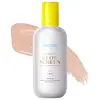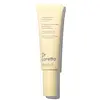Supergoop! Glowscreen Soft-Radiance Drops Mineral SPF 40 Versus Dr. Loretta Universal Glow Daily Defense Mineral Sunscreen Fluid SPF 40
What's inside
What's inside
 Key Ingredients
Key Ingredients

 Benefits
Benefits

 Concerns
Concerns

 Ingredients Side-by-side
Ingredients Side-by-side

Zinc Oxide 15.11%
Cosmetic ColorantWater
Skin ConditioningEthylhexyl Palmitate
EmollientCaprylic/Capric Triglyceride
MaskingPropanediol
SolventDimethicone
EmollientPolyglyceryl-3 Polyricinoleate
EmulsifyingSorbitan Isostearate
EmulsifyingPolyglyceryl-2 Dipolyhydroxystearate
Skin ConditioningFragaria Ananassa Seed Oil
AntioxidantPongamia Pinnata Seed Extract
Skin ConditioningClitoria Ternatea Flower Extract
Skin ConditioningPolyglyceryl-6 Polyricinoleate
EmulsifyingButylene Glycol
HumectantPolyhydroxystearic Acid
EmulsifyingPolysilicone-11
Inulin
Skin ConditioningMagnesium Sulfate
Triethoxycaprylylsilane
Sodium Phytate
Lecithin
EmollientIsopropyl Myristate
EmollientIsostearic Acid
CleansingGluconolactone
Skin ConditioningSodium Benzoate
MaskingCalcium Gluconate
HumectantIron Oxides
Titanium Dioxide
Cosmetic ColorantMica
Cosmetic ColorantZinc Oxide 15.11%, Water, Ethylhexyl Palmitate, Caprylic/Capric Triglyceride, Propanediol, Dimethicone, Polyglyceryl-3 Polyricinoleate, Sorbitan Isostearate, Polyglyceryl-2 Dipolyhydroxystearate, Fragaria Ananassa Seed Oil, Pongamia Pinnata Seed Extract, Clitoria Ternatea Flower Extract, Polyglyceryl-6 Polyricinoleate, Butylene Glycol, Polyhydroxystearic Acid, Polysilicone-11, Inulin, Magnesium Sulfate, Triethoxycaprylylsilane, Sodium Phytate, Lecithin, Isopropyl Myristate, Isostearic Acid, Gluconolactone, Sodium Benzoate, Calcium Gluconate, Iron Oxides, Titanium Dioxide, Mica
Water
Skin ConditioningZinc Oxide
Cosmetic ColorantIsododecane
EmollientPropanediol
SolventCaprylic/Capric Triglyceride
MaskingPolyglyceryl-6 Polyricinoleate
EmulsifyingC12-15 Alkyl Benzoate
AntimicrobialDimethicone
EmollientPolymethylsilsesquioxane/Trimethylsiloxysilicate
Coco-Caprylate/Caprate
EmollientEthylhexyl Palmitate
EmollientPolymethylsilsesquioxane
Disteardimonium Hectorite
StabilisingPolyglyceryl-10 Dioleate
EmulsifyingPolyhydroxystearic Acid
EmulsifyingLecithin
EmollientPhenoxyethanol
PreservativeTapioca Starch Polymethylsilsesquioxane
AbsorbentPropylene Carbonate
SolventPolysilicone-11
Butyrospermum Parkii Butter
Skin ConditioningEctoin
Skin ConditioningGlycerin
HumectantPolyglyceryl-10 Laurate
Skin ConditioningTromethamine
BufferingEthylhexylglycerin
Skin ConditioningOctyldodecanol
EmollientLavandula Angustifolia Oil
MaskingPelargonium Graveolens Flower Oil
MaskingDecyl Glucoside
CleansingDimethylmethoxy Chromanol
AntioxidantSodium Benzoate
MaskingBetula Alba Bark Extract
MaskingBoswellia Serrata Extract
Skin ConditioningPolygonum Cuspidatum Root Extract
AntioxidantCaprylyl Glycol
EmollientHexylene Glycol
EmulsifyingJojoba Esters
EmollientTrihydroxystearin
Skin ConditioningAlumina
AbrasiveCentella Asiatica Extract
CleansingTocopherol
AntioxidantSilica
AbrasiveCI 77891
Cosmetic ColorantIron Oxides
Citronellol
PerfumingGeraniol
PerfumingLimonene
PerfumingLinalool
PerfumingWater, Zinc Oxide, Isododecane, Propanediol, Caprylic/Capric Triglyceride, Polyglyceryl-6 Polyricinoleate, C12-15 Alkyl Benzoate, Dimethicone, Polymethylsilsesquioxane/Trimethylsiloxysilicate, Coco-Caprylate/Caprate, Ethylhexyl Palmitate, Polymethylsilsesquioxane, Disteardimonium Hectorite, Polyglyceryl-10 Dioleate, Polyhydroxystearic Acid, Lecithin, Phenoxyethanol, Tapioca Starch Polymethylsilsesquioxane, Propylene Carbonate, Polysilicone-11, Butyrospermum Parkii Butter, Ectoin, Glycerin, Polyglyceryl-10 Laurate, Tromethamine, Ethylhexylglycerin, Octyldodecanol, Lavandula Angustifolia Oil, Pelargonium Graveolens Flower Oil, Decyl Glucoside, Dimethylmethoxy Chromanol, Sodium Benzoate, Betula Alba Bark Extract, Boswellia Serrata Extract, Polygonum Cuspidatum Root Extract, Caprylyl Glycol, Hexylene Glycol, Jojoba Esters, Trihydroxystearin, Alumina, Centella Asiatica Extract, Tocopherol, Silica, CI 77891, Iron Oxides, Citronellol, Geraniol, Limonene, Linalool
Ingredients Explained
These ingredients are found in both products.
Ingredients higher up in an ingredient list are typically present in a larger amount.
This ingredient is an emollient, solvent, and texture enhancer. It is considered a skin-softener by helping the skin prevent moisture loss.
It helps thicken a product's formula and makes it easier to spread by dissolving clumping compounds.
Caprylic Triglyceride is made by combining glycerin with coconut oil, forming a clear liquid.
While there is an assumption Caprylic Triglyceride can clog pores due to it being derived from coconut oil, there is no research supporting this.
Learn more about Caprylic/Capric TriglycerideDimethicone is a type of synthetic silicone created from natural materials such as quartz.
What it does:
Dimethicone comes in different viscosities:
Depending on the viscosity, dimethicone has different properties.
Ingredients lists don't always show which type is used, so we recommend reaching out to the brand if you have questions about the viscosity.
This ingredient is unlikely to cause irritation because it does not get absorbed into skin. However, people with silicone allergies should be careful about using this ingredient.
Note: Dimethicone may contribute to pilling. This is because it is not oil or water soluble, so pilling may occur when layered with products. When mixed with heavy oils in a formula, the outcome is also quite greasy.
Learn more about DimethiconeEthylhexyl Palmitate, also known as octyl palmitate, is created from 2-ethylhexyl alcohol and palmitic acid. It is a fatty acid ester.
The fatty acid content of Ethylhexyl Palmitate makes it an emollient. Emollients help soften and hydrate your skin by trapping moisture within.
Ethylhexyl Palmitate is also used to help improve the texture of cosmetics. It helps other ingredient dissolve in products and help disperse ingredients more evenly.
You'll likely find this ingredient in sunscreen, as it is often used to mix UV-blocking ingredients such as avobenzone and ethylhexyl triazone.
It can also help stabilize the fragrances in a product as a fragrance fixative.
Ethylhexyl Palmitate can be used to substitute mineral oil.
Due to its high fatty acid content, it may not be fungal-acne safe.
Learn more about Ethylhexyl PalmitateLecithin is a term for a group of substances found in the cell membranes of plants, animals, and humans. They are made up of mixture of phospholipids.
This ingredient has emollient and emulsifying properties.
As an emollient, lecithen helps soften the skin and creates a barrier to keep moisture in.
As an emulsifier, it also helps prevent water and oil ingredients from separating. Lecithin can also help ingredients be better absorbed by the skin.
This is because the phospholipids in lecithin produce liposomes. Liposomes help other ingredients get through the skin barrier.
Depending on the source of this ingredient, lecithin may not be fungal acne safe. This is because some sources of lecithin come from soybean oil, which may feed the malassezia yeast that feeds fungal acne.
We recommend reaching out to the brand you are purchasing from to inquire about the source of their lecithin.
Some other names for this ingredient include soy lecithin and deoiled soy lecithin.
Learn more about LecithinPolyglyceryl-6 Polyricinoleate isn't fungal acne safe.
Polyhydroxystearic Acid is a soft wax made from castor oil.
It is is a texture thickener, emulsifier, and film-former. Emulsifiers prevent ingredients from separating, such as oils and waters.
Polyhydroxystearic Acid may not be fungal acne safe.
Learn more about Polyhydroxystearic AcidPolysilicone-11 is a film-forming silicone that creates a non-tacky and matte finish on the skin. It's commonly used to improve texture, absorb excess oil, and help active ingredients spread evenly.
Due to its "rubber-like" structure, it stays on the skin's surface instead of being absorbed. On the skin, it creates a flexible layer that enhances wearability and stability.
Propanediol is an all-star ingredient. It softens, hydrates, and smooths the skin.
It’s often used to:
Propanediol is not likely to cause sensitivity and considered safe to use. It is derived from corn or petroleum with a clear color and no scent.
Learn more about PropanediolSodium Benzoate is a preservative. It's used in both cosmetic and food products to inhibit the growth of mold and bacteria. It is typically produced synthetically.
Both the US FDA and EU Health Committee have approved the use of sodium benzoate. In the US, levels of 0.1% (of the total product) are allowed.
Sodium benzoate works as a preservative by inhibiting the growth of bacteria inside of cells. It prevents the cell from fermenting a type of sugar using an enzyme called phosphofructokinase.
It is the salt of benzoic acid. Foods containing sodium benzoate include soda, salad dressings, condiments, fruit juices, wines, and snack foods.
Studies for using ascorbic acid and sodium benzoate in cosmetics are lacking, especially in skincare routines with multiple steps.
We always recommend speaking with a professional, such as a dermatologist, if you have any concerns.
Learn more about Sodium BenzoateWater. It's the most common cosmetic ingredient of all. You'll usually see it at the top of ingredient lists, meaning that it makes up the largest part of the product.
So why is it so popular? Water most often acts as a solvent - this means that it helps dissolve other ingredients into the formulation.
You'll also recognize water as that liquid we all need to stay alive. If you see this, drink a glass of water. Stay hydrated!
Learn more about WaterZinc Oxide is a mineral broad-spectrum UV filter; it is the broadest UVA and UVB reflector approved by the FDA. It also has skin protectant and skin soothing properties.
Zinc oxide is one of the most effective broad-spectrum UV filters. It protects against UVB, UVAII, and UVAI. In comparison to its counterpart titanium dioxide, zinc oxide provides uniform and extended UVA protection.
Another great benefit? This ingredient is highly photostable so it won't degrade easily under sunlight.
A common myth is that mineral UV filters are widely believed to primarily reflect UV light.
However, modern research shows titanium dioxide absorbs UV radiation like chemical filters (~95% absorption & 5% reflection).
Zinc oxide has great skin soothing properties so you'll likely find this in sunscreens formulated for sensitive skin or babies/children. It is unlikely to cause "eye sting" like other sunscreen ingredients.
Regulatory agencies consider zinc oxide to be non-toxic and safe. It has also been shown to not penetrate the skin.
Unfortunately, this ingredient does leave a visible white cast. This is why mineral sunscreens are often less cosmetically elegant than chemical or hybrid ones.
In cosmetics, zinc oxide can be found in both non-nano and nano-sized forms. The nano version is used to reduce white cast and improve the texture of sunscreen formulas.
There are ongoing concerns surrounding nano-zinc oxide's impact on marine ecosystems and whether it can be absorbed into skin.
Regarding marine ecosystems and coral reefs, there is no conclusive evidence that any form of zinc oxide (or any other sunscreen ingredients) will cause harm. The science is still developing but many consumers are keeping a close eye on this issue.
Please note, many destinations have reef-safety sunscreen rules. For instance, the U.S. Virgin Islands advises all visitors to use non-nano mineral sunscreens.
There has also been some stir about whether micronized or nano zinc oxide has potential photoxicity and absorption through the skin/lungs.
An in-vitro (done in a test tube or petri dish) study demonstrated micronized zinc oxide to have potential phototoxicity. There's no need to fret; the EU Commission's Scientific Committee on Consumer Safety has stated, "The relevance of these findings needs to be clarified by appropriate investigations in vivo." Or in other words, further studies done on living organisms are needed to prove this.
Current research shows zinc oxide nanoparticles do not penetrate intact or sunburned skin. They either remain on the surface or in the outermost layer of dead skin (stratum corneum).
Zinc oxide is one of only two classified mineral UV filters with titanium dioxide being the other one.
Fun fact: Zinc has been used throughout history as an ingredient in paint and medicine. An Indian text from 500BC is believed to list zinc oxide as a salve for open wound. The Ancient Greek physician Dioscorides has also mentioned the use of zinc as an ointment in 1AD.
Learn more about Zinc OxideThis ingredient is a combination of red, black, and yellow iron oxide pigments. This combination of colors is usually found in foundation, because it results in a "skin" color.